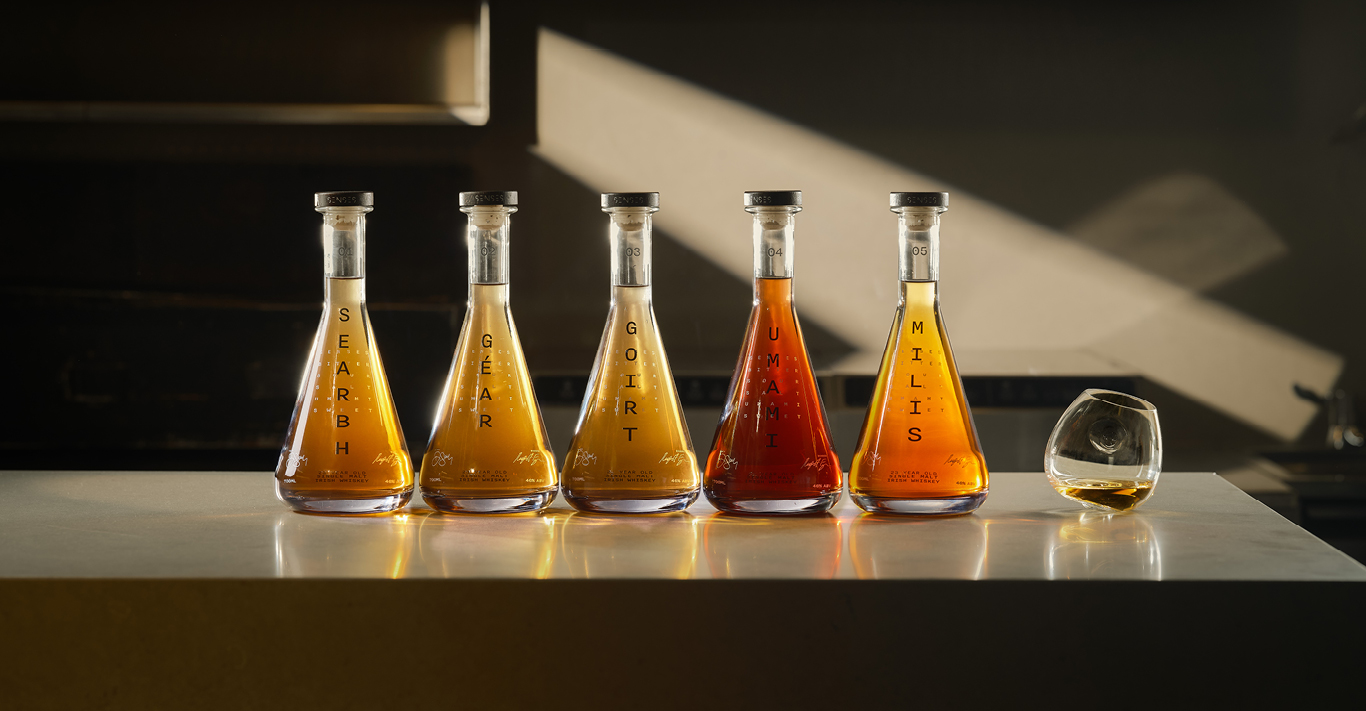WORDS
Chris Madigan
On the shore of Dublin Bay is a suburb of the city best known as the location of a school, Blackrock College, which produces rugby stars such as Brian O’Driscoll and many of Ireland’s current starting 15. But it’s also the home of a restaurant that they couldn’t all fit into. Liath – behind a modest door in the hard-to-spot entrance alley on Blackrock’s Main Street – has only 14 covers. It does have two Michelin stars though. This is where two friends have been discussing the minutiae of taste for many years. Now, that dialogue between chef Damien Grey and Rupert Egan, head bonder of Egan’s Irish Whiskey, has resulted in Senses.
Senses is a set of five bottles of 23-year-old single-malt Irish whiskey, from a single barrel distilled at Cooley, but with each finished in a different cask to imbue it with characteristics of the five individual building blocks of taste: sweet, sour, salt, bitter and umami. There are just 200 sets of Senses available.

The finishing required to lean towards one or two of the taste-senses is fairly straightforward; a madeira cask will up the sweetness and a barrel that has contained stout will introduce bitter notes. But some required a bit of lateral thinking, and each choice has a story around it.
To create Searbh (sharuv, meaning bitter), Egan turned to his own family history. ‘In the 1800s, the Egans were brewers, as well as bonders. We were big producers of IPAs, bitters and stout. One of my cousins was a brewer before we started the modern iteration of Egan’s and is obsessive about working out Victorian mash bills. So we took the old Imperial-stout mash bill – more bitter than a milk stout – and an ex-bourbon barrel to Dot Brew, a cult brewery in Mayo. They brewed it, re-charred and filled the barrel, bottled the stout and we used the cask to finish the whiskey – giving it those coffee and dark chocolate notes.’
There are a few of the bottles of what is an incredible stout left, but Grey is hoarding them to use in breadmaking. Grey says, ‘One of the tricks is to taste the bitter whiskey with unbuttered stout bread first, then try it with a cultured butter that has a certain sourness to it, and then seaweed butter for umami or savoury.’

Like a bartender balancing a cocktail without neutralizing it, he allows one of the tastes to be highlighted without dominating. But, like a whiskey blender, he is looking for different flavours to have a moment before introducing another to the stage. For example, one of the amuse-bouche items is a fermented asparagus tuille: ‘What happens is, when you ferment white asparagus, it has bitter notes at the very beginning and then it goes into sour and ends up with a hint of salt. With that, and a sip of the whiskey and a gulp of the stout, it builds to a sensory overload. So the next step is to take a bouquet of wild herbs, doused in damson vinegar. Smell it and eat it, to reset your taste buds.’
The next whiskey in the journey is Géar (gayr, or sour). Egan identified mezcal as the finishing cask that would, as he says, ‘steer it towards sourness without it crossing into that sense of being off’. He had been in extended talks with Stephen Myers, founder of Ilegal mezcal until suddenly Ilegal was bought by Bacardi… ‘Funny, but our little project in a dilapidated Victorian market in Ireland was not a priority for the new owners! But Stephen introduced me to another distiller, Doug French. And he created a bespoke mezcal for us – a 10-year-old espadín agave, cooked without smoke, because we weren’t looking for bitterness here. There was still 5 litres of it sloshing around in the barrel when it arrived here, so we kept that!’

Goirt (meaning salty – don’t even try to pronounce this if you are English) could have been finished in a Scotch whisky cask that had aged by the sea, but, says Egan, ‘We didn’t want to surrender any of the Irishness or mix metaphors! Then, one day I was at my cousin’s place at Tullamore and spotted a 1948 old price list from P&H Egan wine and spirits importers, which listed all the cognacs our family sold – Hennessy, Martell and Godet Frères. So I contacted Jean-Jacques Godet and told him that our grandfathers used to do business, and could I buy an empty cask off him? Godet makes cognac from the Grande Champagne cru but the maison is out on the coast at La Rochelle, hence that touch of salinity.’
Umami is represented by a Brunello di Montalcino, a rich red wine evocative of tagliata of beef with parmesan shavings and balsamic vinegar. Egan says, ‘It was the moment my wife realised that all our recent holidays had coincidentally taken place near wineries, breweries and distilleries, when I was unsuccessfully attempting to fit two wine casks into a Fiat 500.’ Grey pairs this whiskey with a 19-hour braised beef topped with lardo, with smoked oyster and coastal flora such as sea purslane – just like Tuscany, much of Ireland flows down from the hills to the sea.
The plethora of options for Milis (millish, meaning sweet) – port, dessert wines etc – made it the longest decision-making process. Even when they’d chosen a madeira producer, they still had to decide between six styles.
The result is that, on its own, Milis is the most accessibly delicious of the five. However, it only makes full sense as the conclusion of the sensorial journey – especially if you pair the whiskeys with a meal at Liath, where Grey will not only produce food that dances with each whiskey, but regale you with even more tales of the journey.
Senses by Liath is limited to 200 sets at €5,950 each; enquiries at liathrestaurant.com





